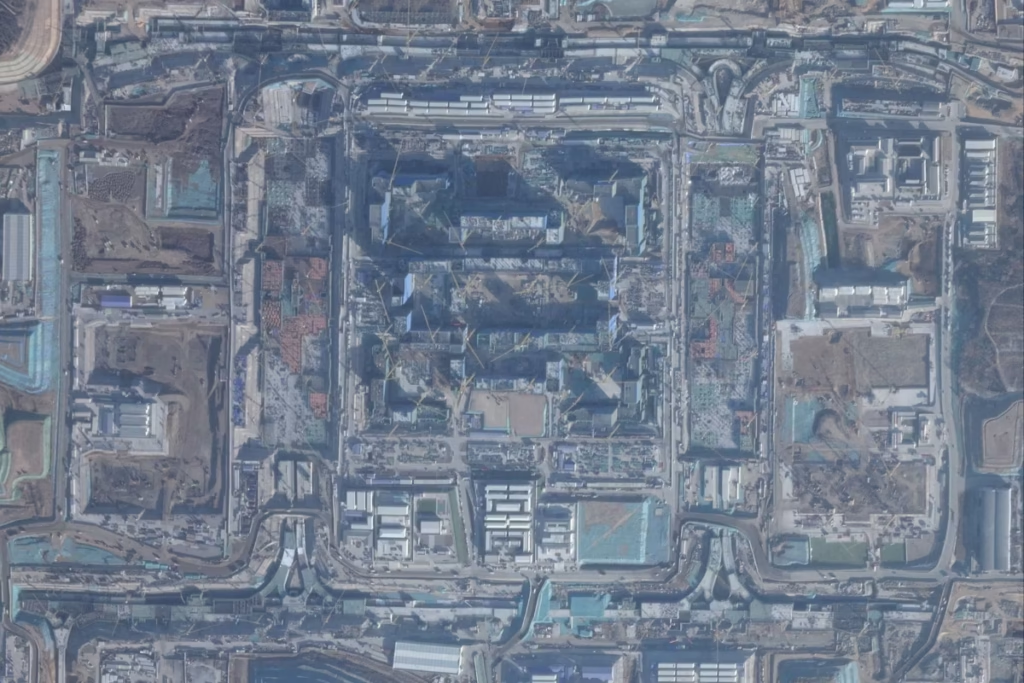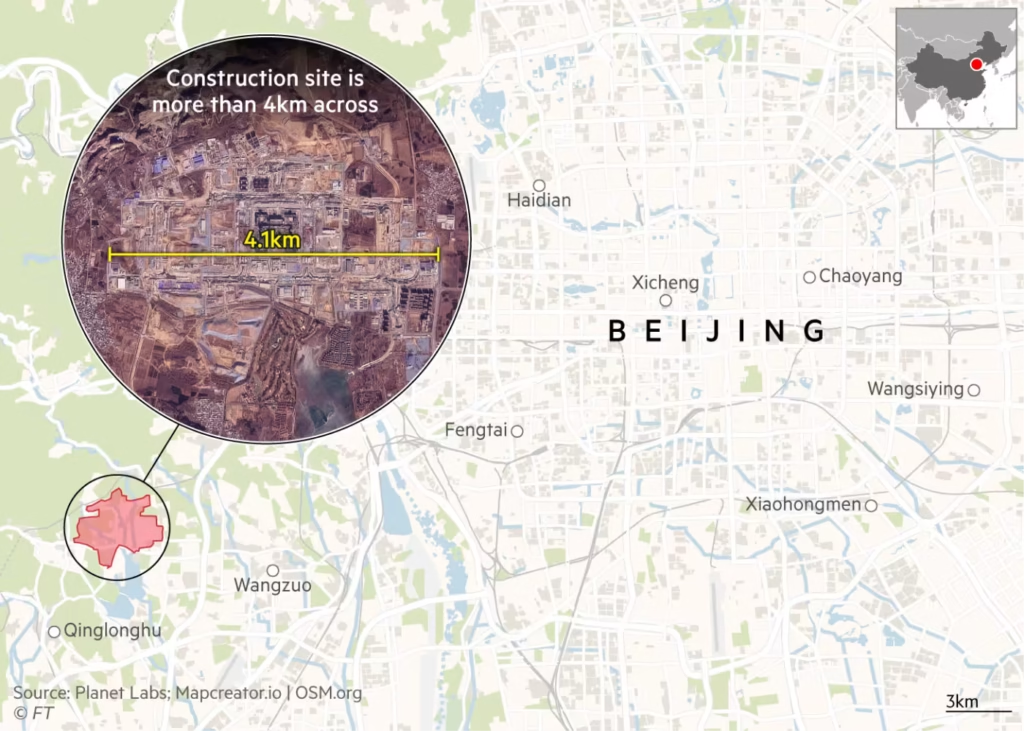
In recent months, international defense analysts have focused on China’s latest grand military infrastructure project, a massive command center and military district Gurmeet(31 January 2025) and Asia Times (03 February 2025) have provided crucial details. The facility spans up to 1,500 acres and is located about 30 kilometers southwest of Beijing.
The PLA is also rapidly expanding its nuclear weapons arsenal and working to better integrate its different branches. Military experts believe the PLA’s lack of integration is among its biggest weaknesses compared with the US armed forces.
1. Understanding China’s New Military District
1.1. What Is the Military District?
China’s People’s Liberation Army (PLA) has long been undergoing structural reforms to modernize its capabilities. At the heart of these efforts is the creation of integrated, joint-command military districts that combine land, naval, air, missile, and cyber forces. The latest project—a sprawling command center sometimes referred to as “Beijing Military City”, is not merely a reorganisational step; it is an enormous, purpose‑built facility designed to serve as the nerve center for operations and as a hardened base to protect China’s top military leadership, even in a nuclear conflict.
1.2. Construction and Strategic Objectives
According to both the Financial Times and Asia Times, the new military district covers up to 1,500 acres and is located approximately 30 km southwest of Beijing. This massive installation is engineered to withstand high-intensity conflict. It includes extensive underground bunkers, redundant communication systems, and spacious logistics zones. Strategically, this facility forms a central pillar of China’s “active defense” doctrine, a strategy that emphasizes absorbing an initial attack and then launching a rapid counterattack.
- Based on an assessment of satellite images obtained by the Financial Times, major construction started in mid-2024. People familiar with the situation said some intelligence analysts had dubbed the project “Beijing Military City”. The construction comes as the People’s Liberation Army develops new weapons and projects ahead of the force’s centenary in 2027.

Photo Courtesy: www.ft.com/content/f3763e51-8607-42b9-9ef9-5789d5bf353d
Photo Courtesy: https://www.ft.com/content/f3763e51-8607-42b9-9ef9-5789d5bf353d
- US intelligence said President Xi Jinping had also ordered the PLA to have developed the capability to attack Taiwan by then (2027).
- The PLA is also rapidly expanding its nuclear weapons arsenal and working to better integrate its different branches. Military experts believe the PLA’s lack of integration is among its biggest weaknesses compared with the US armed forces.
The district’s construction is aimed at ensuring that, even if forward bases are targeted, China’s command and control infrastructure remains intact. This not only deters adversaries by demonstrating the capability to sustain operations under extreme conditions but also enhances China’s ability to coordinate a multi-domain military response.
2. Size and Scale: How Big Is It?
2.1. Benchmarking Against the U.S. Pentagon
The Financial Times report from 31 January 2025 highlights that, by physical footprint, China’s new military district is truly colossal. For comparison, the Pentagon—the United States’ iconic defense headquarters, covers about 6.5 million square feet (roughly 600,000 m²). In contrast, China’s new facility, spread across up to 1,500 acres (approximately 6,070,000 m²), is estimated to be at least ten times larger in terms of overall area.
This vast size enables the new district to house a far greater number of personnel, store extensive equipment, and integrate multiple layers of security. The large footprint also allows for the incorporation of diverse functions, from deep underground bunkers to expansive communications hubs, all designed to ensure uninterrupted command and control even in the event of a major enemy strike.
2.2. Infrastructure Features and Capabilities

Photo Courtesy: https://www.ft.com/content/f3763e51-8607-42b9-9ef9-5789d5bf353d
Key features of the district include:
- Extensive Underground Facilities: Deep bunkers that can protect command centers from conventional and nuclear attacks.
- Integrated Communications Hubs: Redundant networks that maintain secure and continuous data links between various military branches.
- Large Logistics Areas: Vast open spaces designed for the rapid storage and deployment of equipment and supplies.
- Advanced Surveillance Systems: State‑of‑the‑art radars and sensor arrays that ensure early detection of enemy movements.
These capabilities, as detailed in both the Financial Times and Asia Times reports, confirm that the facility is designed not only to project power but also to secure the continuity of command under even the most adverse conditions.
3. Global Context: Other Large Military Districts
3.1. Major Military Districts Worldwide
While China’s new district is unprecedented in size and design, several other nations maintain large military installations:
- United States:
- The Pentagon is about 6.5 million square feet (600,000 m2) of floor space, 3.7 million square feet (340,000 m2) of which are used as offices. It has five sides, five floors above ground, two basement levels, and five ring corridors per floor with a total of 17.5 mi (28.2 km) of corridors, with a central five-acre (2.0 ha) pentagonal plaza. About 23,000 military and civilian employees work in the Pentagon, as well as about 3,000 non-defense support personnel.

Photo Courtesy: telanganatoday.com
- Beyond the Pentagon, the U.S. has large bases such as Fort Bragg and Joint Base Lewis-McChord. However, these are spread out and focus on regional operational readiness rather than serving as a single, centralized, hardened command center.
- Russia: Russian military districts (Western, Southern, Eastern) manage vast regions but typically emphasize regional control over centralized command resilience.
3.2. Comparing Sizes and Roles
China’s project is unique in that it combines a vast physical footprint with an integrated, multi-domain command system. While other countries maintain large military installations, China’s centralized command center—with a footprint of up to 1,500 acres and located just 30 km southwest of Beijing, is designed to be a singular hub for coordinating joint operations and ensuring strategic continuity.
4. The Chinese Military District Landscape
4.1. Historical Evolution: From Military Regions to Theater Commands
China’s military has evolved from a system of traditional military regions into a more integrated network of theater commands. In the 2014–2016 reform, the PLA consolidated its military regions into five theater commands (Eastern, Southern, Western, Northern, and Central) to streamline operations and improve joint command capabilities. The new military district near Beijing complements these reforms by providing a centralized, fortified command hub for the Central Theater Command.
4.2. Other Major Chinese Military Installations
China’s broader military modernization includes:
- Border Districts in Xinjiang and Tibet: Upgraded to support rapid deployment and high-altitude operations.
- Naval Bases in the South China Sea: Artificial islands and reclaimed lands that project maritime power.
- Cyber, Space, and Electronic Warfare Command Centers: Facilities integrated into the PLA’s Strategic Support Force to manage multi-domain operations.
These projects collectively demonstrate China’s strategy to integrate advanced technologies and unified command structures across all domains.
5. The Strategic Scheme Behind China’s Military Districts
5.1. Modernization and Joint Command
China’s military reforms are driven by the need to transition from a large but bureaucratic force to a nimble, technologically advanced military. The new district exemplifies this transformation by:
- Integrating Multi-Domain Capabilities: Bringing together land, air, naval, missile, cyber, and space assets.
- Ensuring Survivability: With a design that protects command functions even during a nuclear attack.
- Enabling Rapid Response: Allowing for seamless coordination and rapid force projection across different operational theaters.
5.2. Active Defense and Power Projection
At its core, the concept of “active defense” guides China’s military strategy. The new military district is designed to:
- Secure Command and Control: Maintain continuity even if forward bases are compromised.
- Enhance Regional Power Projection: Provide the PLA with the ability to quickly coordinate and deploy forces in regions ranging from the South China Sea to the Tibetan Plateau.
- Deter Adversaries: By showcasing a resilient and expansive command center, China signals its readiness to counter any aggression.
5.3. Technological Integration
Advanced technology is a hallmark of this project. The facility incorporates:
- Redundant Communication Systems: To ensure uninterrupted command even under attack.
- Electronic Countermeasures: Capabilities to intercept and disrupt enemy communications.
- Cyber and Space Operations: Reflecting the PLA’s focus on modern warfare that extends beyond the traditional battlefield.
6. Impact on Regional and Global Dynamics
6.1. Impact on India
6.1.1. Border Security and Strategic Parity
India shares a long and disputed border with China, and the construction of a massive, fortified command center near Beijing has significant implications:
- Enhanced Chinese Power Projection: The new facility enables China to coordinate rapid force deployment along the Himalayan borders, potentially increasing pressure on Indian forces.
- Compulsion For Acceleration To Indian Modernization: India may feel compelled to further modernize its military and enhance high-altitude warfare capabilities in response.
- Shifts in Deterrence Dynamics: A more resilient Chinese command structure could tip the balance of deterrence, forcing India to rely more on strategic alliances and advanced technology.
6.1.2. Diplomatic and Economic Repercussions
The project also carries broader implications:
- Diplomatic Signaling: It signals China’s determination to secure its interests and may complicate ongoing diplomatic efforts regarding border disputes.
- Economic Impact: Increased militarization in the region could affect trade routes and disrupt economic stability, particularly if key maritime chokepoints are threatened.
6.2. Impact on the United States
6.2.1. Strategic Competition and Military Balance
For the United States, the emergence of a military district that dwarfs the Pentagon poses strategic challenges:
- Reassessing Deterrence: U.S. defense planners will need to consider the implications of China’s integrated, hardened command center for regional stability.
- Technological Race: The U.S. may be forced to accelerate its own technological advancements in cyber, missile defense, and space operations to maintain a competitive edge.
6.2.2. Global Power Projection and Alliance Dynamics
The U.S. strategy in the Indo-Pacific will likely be influenced by this development:
- Enhanced Alliance Commitments: U.S. allies in the region, such as Japan, South Korea, and Australia, may need stronger security guarantees or will be forced to increase their Defence Expenditure.
- Operational Adjustments: The U.S. might need to adapt its force posture and operational doctrines to counter the integrated multi-domain capabilities of China’s new district.
7. The Broader Picture: Chinese Military Strategy and Global Implications
7.1. Shifting from Reactive to Proactive Posture

Photo Courtesy: swarajyamag.com/defence
China’s military modernization is moving from a reactive defense toward a proactive, multi-domain approach. The new military district is a tangible demonstration of this shift, ensuring that command and control remain intact even during a major enemy strike.
7.2. The Global Contest for Technological Superiority
The facility underscores the global race in technological advancements:
- Cyber, Space, and Electronic Warfare: Its integrated systems reflect China’s commitment to excelling in these critical domains.
- Advanced Engineering: The construction techniques and materials used are among the most advanced in modern military infrastructure, reinforcing China’s industrial capabilities.
7.3. Implications for Global Stability
The establishment of such a massive military district has significant ramifications:
- Regional Security Dilemmas: Neighboring countries may increase their own defense spending, potentially triggering regional arms races.
- Reassessing Alliances: Global security architectures, particularly those led by the United States, may need to be re-evaluated in light of China’s enhanced power projection capabilities.
8. Conclusion
China’s construction of what is being termed the world’s largest military district is a bold demonstration of its military modernization and strategic ambition. Verified by recent reports from the Financial Times (31 January 2025) and Asia Times (03 February 2025), the facility spans up to 1,500 acres and is located about 30 kilometers southwest of Beijing. This colossal command center, designed to be at least ten times larger in footprint than the Pentagon—integrates multi-domain capabilities, ensuring resilient command and control even under severe attack.
More than a mere construction project, the new district represents China’s shift toward a proactive, integrated military doctrine that emphasizes rapid counterattack and power projection. For India, this development highlights an urgent need to bolster border defenses and modernize its own forces, while for the United States, it calls for a reassessment of strategic deterrence and alliance commitments in the Indo-Pacific region.
In the global contest for technological and military superiority, China’s massive military district signals a new era in command and control infrastructure—one that could reshape regional dynamics and influence international security for years to come.







